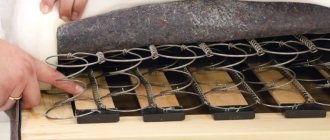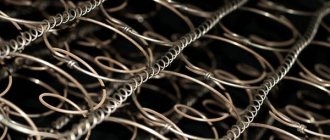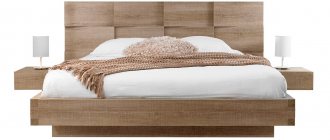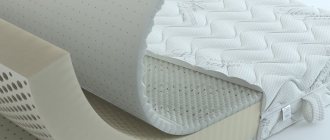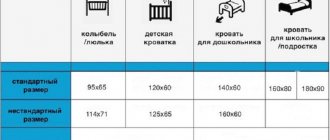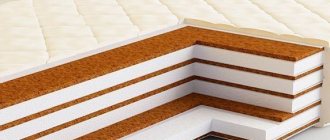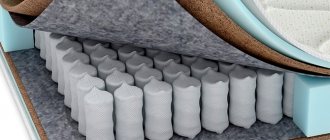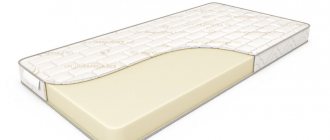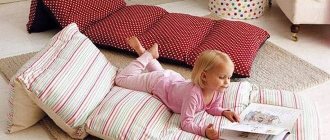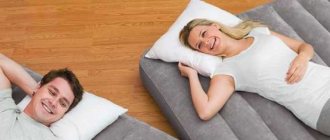Good sleep is the key to health and good mood. To do this, it is important to properly organize your sleeping area. The health of the spine and the comfort of body position directly depend on the chosen mattress. Therefore, it is necessary to understand the nuances of choosing a product and understand what a spring block is.
The basis of most modern mattresses is a spring block
Mattress with independent spring block
Independent spring mattresses vary depending on the number of springs per square meter
A mattress equipped with independent spring blocks is a design with no interaction between the springs. Each of them is in a special case. This allows you to create an orthopedic effect that affects every part of the body to the required extent.
Levels of anatomical effect using spring blocks as an example
Disadvantages of independent springs
The main disadvantage of independent springs is their high price. It is due to more complex and costly production.
Sometimes it happens that the spring block does not withstand the entire declared service life. This manifests itself in the fact that the individual bag of the block, the filler, and then the mattress cover are torn. These troubles are associated with improper use of the mattress, when the user’s weight is not taken into account when purchasing. Spring blocks cannot withstand excessive load. The second reason is a violation of manufacturing technology.
When selecting a mattress for permanent use, spring mattresses based on independent blocks are preferred. They ensure the anatomically correct position of the spine, proper rest, and stable functioning of the internal organs. Anatomicity increases with the number of spring blocks. The high price is compensated by a long service life. For more effective use of orthopedic mattresses with independent spring blocks, one should take into account the compliance of the mattress parameters with the weight, needs, and physical condition of the person for whom it is intended.
Bonnell spring block - what is it?
In dependent spring blocks, all springs have a bicone shape and are connected by continuous weaving
A reinforced version of the classic Bonnel spring block, in which the entire mattress area is reinforced with blocks of high-density polyurethane foam
This spring block is in demand. He is a "dependent" species. Because the internal structural elements are interconnected. As a result, each spring depends on the others. A special method is used to fasten them.
The bonnel spring block consists of 5-turn springs made of steel wire
The radius is constantly decreasing and increasing. Toward the center of the product, the spring block and its parts narrow, and begin to expand at the edges. Thanks to this system, the load is distributed evenly and maintains optimal body position.
Mattresses based on a Bonnel spring block have a long service life, are well ventilated and dry quickly when wet
The springs are made of high quality steel. To connect them, special frames or wire with knots are used. Unwinding is avoided by special locks on the structure. Weaving can be with five or four turns. In the first case, the mattress is higher and costs more.
All springs in the mattress at the top and bottom are connected to each other by a steel spiral and limited by a metal frame
Types of spring blocks in mattresses
Equipment for the production of independent spring blocks allows us to produce products of certain types and sizes. These blocks form the basis of the vast majority of mattresses. Having their own workshops for producing independent springs, mattress manufacturers assign their own trade names to them (PocketSpringSilent, EVS, Hour Glass-2000, etc.) In this article we will show how to evaluate the quality of springs in a mattress using objective indicators.
Independent spring blocks can be roughly divided into the following types:
- Economy - sparse arrangement of springs made of steel wire. Thin spunbond is used as the cover material. For 1 m2 in such a block there are only 210 springs with a diameter of about 6.5 cm.
Economy class independent springs
- The standard is Pocket Spring and all its varieties: TFK with 250-310 springs, EVS 500 with 250 springs per 1 square meter, arranged in rows, and Vernestet S300 and 4D Matrix blocks, in which 296-310 springs are placed per 1 m2 due to the dense arrangement not in rows, but in honeycombs. Laying takes place in spunbond covers. The shape, number of turns, and thickness of the wire in the springs may vary. The most common parameters are: spring diameter about 6 cm, height 13 cm, wire thickness 1.8 mm. The configuration, fitted or barrel-shaped, does not make noticeable changes to the consumer properties of the standard block.
- Improved - this class includes the so-called Multipocket springs (510 springs/m2), Micropocket (1024 springs/m2), as well as blocks of a special design that have unique properties (a spring in a spring, a combination of springs of different heights).
They give mattresses a high ability to adapt to body contours and can withstand increased weight loads. Characteristics of the most common blocks: Multipocket, spring diameter 4.5 cm, height 15-16 cm, wire thickness from 1.3 mm. Micropocket - spring diameter from 2.6 cm, height 15-16 cm, wire thickness from 1 mm. The shape of the springs of the improved block is exclusively barrel-shaped; they can be placed in covers made of spunbond (undesirable) or a more abrasion-resistant, voluminous and breathable fibertex material. Spring zone unit 20000
Spring mattress blocks: types
Orthopedic spring mattresses of different types
Spring blocks can work in compression or tension. The first type is often used in the manufacture of standard mattresses. Among the types of blocks, the main ones are:
- dependent;
- acting autonomously or independently.
It has already been noted that in the first case, each internal part depends on the others and is connected to them. In another form, each element acts independently and does not interact with the others.
The difference in using a spring block with independent and dependent springs
Experts consider this option more suitable for healthy sleep, but it is more expensive. A mattress with a dependent spring block is cheaper. You can choose a quality option for a good rest.
Mattresses with independent springs. Things to consider when choosing
Products equipped with independent blocks consisting of springs may differ in cost and some quality indicators. The higher the orthopedic effect, the higher the cost of the mattress. This is due to the presence of high-quality physiological support for the spine and the whole body, the production of which requires large costs.
The following materials can be used as filler:
- struttofiber;
- spunbond;
- latex;
- thermal felt;
- polyurethane foam;
- coconut coir.
Build quality and filler will play an important role when choosing a product. The blocks are placed on the filler and then re-coated with an auxiliary layer. The mattress is placed in a fabric cover, which can be washed if necessary. The quality of the filler must be of an appropriate level. The following requirements apply to him:
- hypoallergenic;
- antibacterial;
- antistatic.
When choosing a product, you should take into account parameters such as the person’s physical condition, age and weight. The combination of polyurethane foam and coconut coir is considered optimal.
Level of orthopedic effect
Orthopedic mattresses can be of three types: hard, medium and soft. Products of medium hardness are considered the golden mean. Suitable for almost any person who does not suffer from diseases of the musculoskeletal system and does not have problems with the spine. You can enhance the orthopedic effect of a mattress by choosing the right model. To do this, many factors are taken into account, the key ones being the height, weight and age of the owner. Overweight people use hard surfaces to sleep. Models can be either spring or springless. Hard mattresses are recommended for people under 25 years of age. The older the person, the softer the mattress should be. Before purchasing, you should consult with an orthopedist and your doctor, if you have one.
By type of design
The differences between orthopedic mattress models lie in the design. Products can be springless or spring. The spring models will be based on a special system of springs, which can be arranged using independent and dependent blocks. If the springs are interconnected, then when pressure is applied to one of them, the others will be affected. "Bonnel" belongs to the category of spring blocks, the density of which will be 100 units per meter. The cost of such products is low. Non-polyurethane, holofiber or latex can be used as filler.
Independent springs are placed in separate cases that cannot come into contact with adjacent elements. Natural latex, orthopedic foam or felt will be used as an intermediary. The model parameters will depend on the type of material selected. Based on the number of springs used, spring mattresses differ from each other. In springless models, the main thing will be the filler. Mattresses can be either combined or monolithic, depending on the type and number of layers of filler used. Polyurethane foam, coconut coir or latex are used as raw materials.
Advantages of an independent spring block in mattresses
In sofa beds and mattresses, independent spring blocks have received many positive reviews, largely due to the following positive qualities:
- If you have sleep disturbances and lack of peace during the night (frequent turning over and getting up), your bedmate will not feel anything. This is due to the fact that the springs are not connected to each other.
- Ability to withstand significant loads (up to 200 kg).
- Durable, removable cover. The material is hypoallergenic, natural and breathable.
- Long service life. Using only high-quality raw materials and modern technologies.
- Distribution of the load on the vertebrae. The organs and spine are in weightlessness, since there is no pressure on them.
- Complete muscle relaxation. A person sleeps more soundly and gets enough sleep thanks to complete relaxation.
- Anatomical impact. Sleep becomes comfortable, and the body is positioned correctly.
Difference between independent and dependent spring unit. Why are we overpaying?
The spring block can be with an independent or dependent system. It is worth understanding the main differences between the types. This will allow you to make the right choice when buying a mattress. To find out the differences, you need to clarify the main characteristics:
- Block with dependent springs. They intertwine with each other, forming a single mechanism. The mattress consists of steel wire parts. Models are divided according to the density of the springs and their diameter. The lower the last indicator and the higher the density, the better the body will be supported during sleep. The advantages of the system are accessibility, due to low cost, and the ability to withstand heavy loads. Over time, the spring block may become deformed and the product will begin to sag. The person sleeping next to him feels all the movements of the other person during sleep.
- Independent block. The springs act independently, regardless of each other. The characteristics of the springs directly affect the stiffness of the product and its density. This allows him to become an orthopedic. Thanks to independence, each spring compresses without affecting the others. The load is distributed evenly, the mattress follows the contours of the body. If one of the springs fails, this will not affect the entire product. One of the key disadvantages of an independent type spring block is its high cost.
"TFK" (TFK) - a classic spring block with the number of springs about 250 springs / sq.m.
“Multipocket” - about 500 square meters/sq.m with the number of turns usually 8-10 with a spring height of about 13-14 cm, more “anatomical” compared to “TFC”
“Micropacket” (Micropocket) - about 1000 p/sq.m, with the number of turns usually 12-14 with a spring height of about 13-14 cm, significantly more expensive than the previous 2
An independent system does not help heal a bad back. But it will be an excellent preventive measure for maintaining health. If a mattress is purchased for a place of relaxation and not sleep, then you should not overpay and just choose a dependent system. In other cases, it is better to choose a block with independent springs.
Dependent spring block
The spring system, called "bonnel", which translates from French as "waist", was patented in 1883 by Joseph Leggett, and since then has hardly ever been modernized or improved. Today, mattresses with a dependent block account for almost 30% of sales worldwide.
The block is a complex of four-turn or five-turn springs intertwined along the entire length. The springs have a bicone shape with a narrowing in the center and widening towards the edges, which provides additional elasticity and support. Due to the lack of an alternative, mattresses with the Bonnell system remained for a long time a kind of monopoly among bedding accessories, but even then such shortcomings of the block as the inability to withstand heavy loads and rapid wear of the springs were discovered. However, it is still used in mattresses today: its practicality and low cost make it a suitable solution for occasional use.
Packaging of independent springs, type of material and method of fastening
The most vulnerable part of the product is the upper shell of the material. It is regularly exposed to springs. Therefore, weak fabric can easily be damaged. You should pay special attention to the material. The service life of the mattress depends on this. The packaging of the spring block with an independent system is also important. Spunbond and fibertek are used. The latter is more durable.
The durable fabric upper shell of the independent spring unit significantly increases the service life of the unit
When manufacturing the product, the non-woven part is welded using ultrasound. The close location of the gluing points to the middle of the pocket allows the springs to work more independently, enhancing the orthopedic properties. Also, a special glue is used for connection, which leads to the appearance of a specific odor. Over time it disappears.
Mattresses basics: spring blocks, springless support systems and their features
THE BASE OF A MATTRESS IS ITS HEART. The basic properties of the mattress depend on the base. Below is brief information about the most common types of bases, which can be divided into 2 large classes - spring and springless.
SPRING BLOCKS The Bonnel dependent spring block is a classic spring block that has been used in the production of mattresses for more than 100 years. It is a system of springs rigidly fastened together (about 240 per bed). It does not have any orthopedic or anatomical effect, cannot accurately replicate the shape of the sleeping person’s body and provide good support for the spine, and also has the so-called “wave effect” - the entire mattress oscillates when one of the sleepers, for example, sits down (in a double mattress ), or a light wife constantly slides towards a heavy husband. Currently, it is used only in cheap mattresses due to its low cost, ease of production and popularity “out of habit”. Our store recommends choosing such a mattress only if money is very tight; it is better to pay attention to mattresses with an independent spring block or springless mattresses.
A block of independent springs ~500 units/bed – the best price/quality ratio. Good orthopedic and anatomical effects. A high level of comfort, with a fairly thick filler (at least 3 cm). This is a system consisting of springs that are not fastened together, each of which is placed in a fabric bag. Due to this design, the mattress can accurately follow the shape of your body and correctly distribute the load on the spine. Does not have a “wave effect”. Doesn't creak. Lasts longer than dependent spring units. The most common block in this category today is TFK. If you want a good mattress for a reasonable price, this is your choice.
A block of independent springs ~1000 units/bed – good price/quality ratio. Excellent orthopedic and anatomical effects. An excellent level of comfort, with a fairly thick filler (at least 3 cm). This is a system consisting of springs that are not fastened together, each of which is placed in a fabric bag. Due to this design, the mattress can accurately (much more accurately than blocks with 500 ave./place) repeat the shape of your body and correctly distribute the load on the spine. Does not have a “wave effect”. Doesn't creak. As a rule, such blocks are made from the best materials, have greater reliability and a long service life. The most common block in this category today is the S1000. If you are looking for a truly comfortable, and most importantly, healthy mattress for your back and joints, this is your choice.
Block of independent springs 2000+ pr./bed – elite spring block. Excellent orthopedic and anatomical effects. An incredible level of comfort, with a fairly thick filler (at least 3 cm). This is a system consisting of thousands of very small springs that are not fastened together, each of which is placed in a fabric bag. Due to this design, the mattress perfectly follows the shape of your body and correctly distributes the load on the spine. Does not have a “wave effect”. Doesn't creak. Such blocks are made from the best materials, have great reliability and a very long service life. The most common block in this category today is the S2000. If you are not used to saving on your health and want to enjoy a restful sleep every night, this is your choice.
Spring in a spring “Duet” (DS, Dual Spring) is an elite spring unit, specially designed for couples with a weight difference of more than 40 kg. Excellent orthopedic and anatomical effects. An excellent level of comfort, with a fairly thick filler (at least 3 cm). This is a system consisting of double, unfastened springs of different diameters, each of which is placed in a fabric bag. One spring, slightly smaller in height and diameter, is placed inside another, larger one. Due to this design, only the large spring “works” under the lighter person, while under the heavier person both springs are activated, providing the proper level of body support for both sleepers. The mattress follows the shape of your body well and correctly distributes the load on the spine. Does not have a “wave effect”. Doesn't creak. Such blocks are made from the best materials, have great reliability and a very long service life. The most common block in this category today is DS; there are also blocks with triple springs. If you are a couple, your weight difference is more than 40 kg, and you are not used to saving on your health - this is your choice.
SPRINGLESS MATTRESS BASES Springless mattresses consist entirely of filler (for example: coconut, latex or PU foam). Such bases can be divided into 2 main types: homogeneous and mixed. Depending on the combination of fillers and the use of various technologies, such as zoning (different hardness in different areas of the mattress), they have: orthopedic and anatomical effects from good to excellent. They do not have a “wave effect”. They do not have an electromagnetic field. They don't spring. They have a long service life.
Homogeneous These are mattresses consisting entirely of one type of filler. As a rule, this is polyurethane foam (PPU), coconut or latex.
Polyurethane foam (PPU) - the best price/quality ratio. Good orthopedic and anatomical effects. Good level of comfort. This is a porous artificial material with medium to high rigidity. Recommended as an alternative to cheap spring mattresses. To achieve greater comfort, more expensive models use zoning, and a combination with micromassage foams (for example, Ergo Foam) is wear-resistant and durable. Its characteristics resemble latex, but with greater rigidity. Safe, hypoallergenic, mold resistant. A good filler for mid- and low-price mattresses.
Latex is a premium material. Excellent orthopedic and anatomical effects. Incredible level of comfort. This is a natural material that is produced from the milky sap of rubber plants. It has a pleasant elastic softness and good wear resistance. Not susceptible to rotting and mold. Has excellent breathability. It is the most environmentally friendly and comfortable filling for mattresses at the moment. Safe for health and hypoallergenic. If you are not used to saving on your health and want to enjoy a restful sleep every night on a soft mattress, this is your choice.
Coconut coir is a premium material. Excellent orthopedic effect. The hardest mattress. This is a natural material made from latex coconut fibers. It is the most common elastic-hard mattress filler. Has excellent resistance to high loads. Environmentally friendly, hypoallergenic and durable material. Also, in recent years, other rigid fillers have increasingly begun to be used, such as Tampico, Linen, Sisal, Babana coir: they all have characteristics similar to coconut, slightly superior to it in durability, rigidity, elasticity or environmental friendliness (heat-treated flax). If you are not used to saving on your health and like the hardest mattress possible, this is your choice.
Combined These are bases consisting of layers of different fillers with different properties, thanks to which it is possible to achieve better orthopedic and anatomical effects, a larger range of possible hardness, or to obtain a double-sided mattress with different hardness on each side.
Tips for choosing a mattress
The mattress should be neither too soft nor too hard, but exactly as required by the client’s weight, dimensions and personal preferences
To make an informed choice, you should rely on the following characteristics.
- Size. If you already have a bed, you should measure it and choose a suitable mattress option. In other cases, you must first determine the dimensions of the bed.
Before purchasing a mattress, you need to take basic measurements of the bed. - Weight. It is necessary to correctly correlate the rigidity of the model and the heaviness of the sleeper. The more the sleeper weighs, the firmer the mattress should be purchased.
When choosing the firmness of a mattress, you need to take into account individual characteristics - Block type. The main characteristics of a dependent and independent system have already been noted.
- Manufacturer. You should only contact trusted companies that have proven themselves on the positive side.
Sleep comfort depends on the choice of mattress and its components. Therefore, you should take your choice seriously. This will keep your back healthy and ensure sound sleep.
